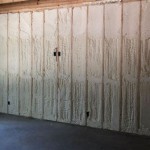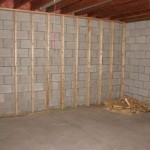How To Fix Hairline Cracks In Basement Walls
Hairline cracks in basement walls are a common occurrence in many homes, particularly those built on expansive soils or subjected to significant temperature fluctuations. While often dismissed as purely cosmetic issues, these cracks can be indicative of underlying structural movement and, if left unaddressed, may lead to water infiltration, mold growth, and further deterioration of the foundation. Addressing hairline cracks promptly and effectively is crucial for maintaining the structural integrity and longevity of the home.
Before embarking on any repair, it is imperative to thoroughly assess the nature and extent of the cracking. This involves a careful visual inspection of the basement walls, both interior and exterior if accessible. Document the location, length, width, and pattern of the cracks. Note whether they are vertical, horizontal, or diagonal. Vertical cracks are often the result of settling, while horizontal cracks may indicate more significant structural problems like soil pressure against the foundation. Diagonal cracks can be caused by a combination of factors. Also, observe if there is any evidence of water seepage or efflorescence (a white, powdery deposit indicating moisture migration through the concrete).
Accurately determining the cause of the cracks is crucial for selecting the appropriate repair method. Settlement, hydrostatic pressure, thermal expansion and contraction, and soil composition are all potential contributing factors. If there are concerns about significant structural issues or ongoing foundation movement, it is advisable to consult with a qualified structural engineer. A professional assessment can provide valuable insights and guidance on the best course of action.
Key Point 1: Preparing the Crack for Repair
Prior to applying any repair material, the crack must be properly prepared to ensure optimal adhesion and a long-lasting seal. This typically involves cleaning and widening the crack to create a suitable surface for the patching compound. Begin by removing any loose concrete, dirt, or debris from the crack using a wire brush or a concrete scraper. A vacuum cleaner can be used to remove any remaining dust and particles.
Widening the crack slightly with a cold chisel and hammer is often necessary. This creates a V-shaped groove that allows for better penetration and bonding of the repair material. Exercise caution when using the chisel to avoid damaging the surrounding concrete. The width and depth of the groove should be sufficient to accommodate the chosen patching compound, typically around ¼ to ½ inch wide and deep. After widening the crack, thoroughly clean it again to remove any newly dislodged particles.
For optimal adhesion, many professionals recommend dampening the inside of the crack with water prior to applying the patching compound. This helps to create a stronger bond between the existing concrete and the repair material. However, avoid saturating the crack, as excess water can dilute the patching compound and weaken its effectiveness. A light misting of water is usually sufficient.
Key Point 2: Selecting the Appropriate Repair Material
Several different types of repair materials can be used to fill hairline cracks in basement walls, each with its own advantages and disadvantages. The choice of material will depend on the width and depth of the crack, the potential for water infiltration, and the desired level of durability. Common options include epoxy injection, hydraulic cement, and polyurethane caulk.
Epoxy injection is a popular method for sealing cracks that are actively leaking water or that are subjected to hydrostatic pressure. Epoxy is a strong, durable material that bonds well to concrete and is resistant to water penetration. The process involves injecting epoxy resin into the crack under pressure, filling it completely and creating a waterproof seal. Epoxy injection is typically best suited for hairline cracks that are less than ¼ inch wide. It often requires specialized equipment and may be best left to professionals.
Hydraulic cement is a fast-setting cement-based patching compound that is designed to expand as it hardens, creating a watertight seal. It is a good option for repairing cracks that are actively leaking water, as it can set even in wet conditions. Hydraulic cement is relatively easy to apply and is suitable for both hairline cracks and wider cracks. However, it can be brittle and may not be as durable as epoxy in situations where there is significant movement in the foundation.
Polyurethane caulk is a flexible sealant that is suitable for filling hairline cracks and expansion joints. It is resistant to water and can accommodate minor movement in the foundation. Polyurethane caulk is relatively easy to apply and is a good option for cracks that are not actively leaking water. However, it may not be as durable as epoxy or hydraulic cement in situations where there is significant hydrostatic pressure.
Key Point 3: Applying the Repair Material
The application of the repair material will vary depending on the type of material chosen. However, there are some general guidelines that apply to most methods. Always follow the manufacturer's instructions carefully to ensure proper application and optimal results.
When using epoxy injection, a series of injection ports are typically installed along the length of the crack. The epoxy resin is then injected into the ports under pressure, filling the crack from the bottom up. The ports are usually removed after the epoxy has cured, and the surface is smoothed over. This process often requires specialized equipment and knowledge, making it more suitable for professional application.
For hydraulic cement, mix the cement with water according to the manufacturer's instructions to create a thick, paste-like consistency. Using a trowel or putty knife, pack the hydraulic cement firmly into the prepared crack, ensuring that it fills the entire void. Smooth the surface of the cement flush with the surrounding concrete. Keep the repaired area damp for several days to allow the cement to cure properly. Follow the manufacturer's instructions regarding curing time and specific recommendations.
When applying polyurethane caulk, use a caulk gun to apply a bead of caulk along the length of the crack. Smooth the caulk with a wet finger or a caulk smoothing tool to create a neat and even seal. Allow the caulk to cure according to the manufacturer's instructions. Depending on the product, painting may be possible after the caulk has fully cured.
Once the repair material has been applied and allowed to cure, inspect the area carefully to ensure that the crack has been completely sealed. If any gaps or voids are visible, reapply the repair material as needed. It is also important to monitor the repaired area periodically for any signs of new cracking or water infiltration. Addressing any new issues promptly can prevent more serious problems from developing.
Furthermore, consider addressing the underlying causes of the cracking. This may involve improving drainage around the foundation, correcting soil erosion, or addressing any structural issues that may be contributing to the problem. Consulting with a qualified professional can help determine the best course of action for preventing future cracking and maintaining the structural integrity of the basement walls.
Properly addressing hairline cracks in basement walls is essential for protecting the home from water damage and maintaining its structural integrity. By carefully assessing the nature and extent of the cracking, selecting the appropriate repair material, and applying it correctly, homeowners can effectively seal these cracks and prevent further deterioration. Remember to always prioritize safety and consult with a qualified professional if there are any concerns about structural issues or ongoing foundation movement.

How To Repair A Large Basement Wall Crack Stop Leaking Permanently

Foundation Crack Repair How To Permanently Fix

How To Seal Basement Cracks

Cracked Walls 101 Types Causes And Fixes

Infrastruct Fix Basement Leaks And Wall Cracks With Prime Resins 900xlv Foam

Repairing Cracks In Walls How To Guide

How To Repair Cracks In Vertical Concrete Surfaces With Quikrete

Diy Foundation Crack Iection Repair Costs Methods Risks Renco Home Improvements

Diy Foundation Crack Repair Kit Urethane Radonseal

Crack On Wall Cause And Effect
Related Posts







